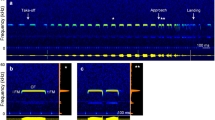Abstract
Doppler-compensating, echolocating bats like the mustached bat (Pteronotus p. parnellii) present excellent models for studying how sensory feedback controls subsequent motor behavior, i.e., how auditory feedback may regulate vocalization. The mustached bat emits stereotyped orientation sounds consisting of a brief rising frequency modulation (FM) followed by a long constant frequency (CF) component and ending in a short downward sweeping FM. Doppler-shifts of the echo frequency result from the difference in the bat’s velocity with respect to its surroundings. During “Doppler-shift compensation ” (DSC), these bats actively compensate for Doppler-shifts in the echo by offsetting the frequency of the orientation sound in order to stabilize the echo at the “reference frequency” (about 100–150 Hz higher than the “resting frequency” emitted when the bat detects no Doppler-shift; Schnitzler, 1968, 1970). The variability in the CF frequency emitted during DSC as observed during obstacle avoidance tests is typically ±10 to ±110 Hz (Jen and Kamada, 1982). The precision with which mustached bats control the frequency of their emitted sounds, and consequently echo frequency, is regulated directly by feedback of information from echoes. The aims of this study were to define central vocal control regions, clarify their role in the production of echolocation sounds, and investigate the role of auditory processing in the control of vocal frequency.
Access this chapter
Tax calculation will be finalised at checkout
Purchases are for personal use only
Preview
Unable to display preview. Download preview PDF.
Similar content being viewed by others
References
Jen, P.H.-J., and Kamada, T., 1982, Analysis of orientation signals emitted by the CF-FM bat, Pteronotus p. parnellii and the FM bat, Eptesicus fuscus during avoidance of moving and stationary obstacles, J. Comp. Physiol, 148: 389.
Schnitzler, H.-U., 1968, Die Ultraschall-Ortungslaute der Hufeisen-Fledermause (Chiroptera-Rhinolophidae) in verschiedenen Orientierungssituationen, Z. vergl. Physiol, 5 7: 376.
Schnitzler, H.-U., 1970, Echoortung bei der Fledermaus Chilonycteris rubiginosa, Z. vergl. Physiol, 68: 25.
Suga, N., Schlegel, P., Shimozawa, T., and Simmons, J.A., 1973, Orientation sounds evoked from echolocating bats by electrical stimulation of the brain, J. Acoust. Soc. Amer, 54: 793.
Suga, N., Simmons, J.A., and Shimozawa, T., 1974, Neurophysiological studies on echolocation systems in awake bats producing CF-FM orientation sounds, J. Exp. Biol, 61: 379.
Author information
Authors and Affiliations
Editor information
Editors and Affiliations
Rights and permissions
Copyright information
© 1988 Plenum Press, New York
About this chapter
Cite this chapter
Gooler, D.M., O’Neill, W.E. (1988). Central Control of Frequency in Biosonar Emissions of the Mustached Bat. In: Nachtigall, P.E., Moore, P.W.B. (eds) Animal Sonar. NATO ASI Science, vol 156. Springer, Boston, MA. https://doi.org/10.1007/978-1-4684-7493-0_25
Download citation
DOI: https://doi.org/10.1007/978-1-4684-7493-0_25
Publisher Name: Springer, Boston, MA
Print ISBN: 978-1-4684-7495-4
Online ISBN: 978-1-4684-7493-0
eBook Packages: Springer Book Archive




